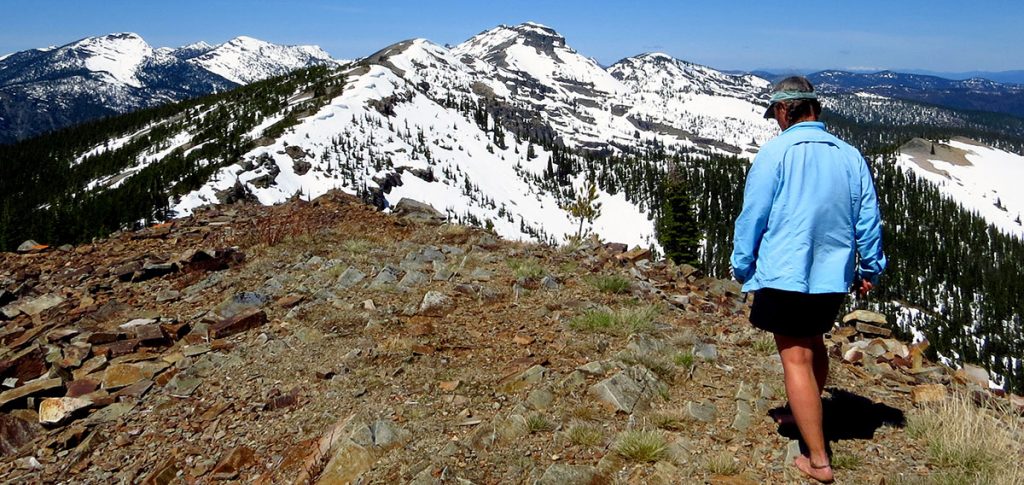Advocating for Change
From the Winter 2017 Issue
Sandii Mellen

Porter Fox is not a fortune teller. He has no crystal ball.
Rather, he is a skier turned ski writer – the most prolific in the industry, known for his meticulous research and fierce love of winter and snow and the lifestyle they support.
So when Fox’s attention turned to Earth’s elevating temperature, and its potentially devastating impact on winter, he was driven to share that story everywhere he could find a listening or reading audience.
He didn’t have to deal in hypotheticals. Everything he wrote about and talked about was happening already.
“I didn’t read the future,” Fox said in a recent interview. “We are seeing it now. The scientists say global warming will increase the number and severity of wildfires, and we’re seeing that; that there will be a more erratic pattern of winter weather, which we’re seeing; that we’ll have fewer blizzards but larger blizzards, fewer storms but larger storms, which we’re seeing.”
He added: “Our planet’s climate is warming. And when it gets hot, snow melts. That is the simple reality that cannot be avoided. As long as the climate is warming, you’ll see less and less snow around the world. And regardless of what your politics are or how many snow guns you’ve got, there is no way to stop what a 2- or 3-degree temperature increase will mean: less snow in the backyard and in the mountains, less runoff, diminished streamflows, degraded river habitat.”
And so in 2014, Fox wrote “Deep: The Story of Skiing and the History of Snow,” a call to action for skiers, snowboarders, winter resorts and their attendant communities.
Every year since has been hotter than all years before it.
DEEP THOUGHTS
Fox grew up in Maine and learned to ski on slopes that were “more blue than white,” owing to the snowmaking machines that delivered the lower-elevation coverage. He wasn’t an immediate convert to the sport, he said. “It was cold. And uncomfortable.”
Then came the day when the forces aligned – as did Fox’s ski turns – and he had found a lifelong passion. He watched his first Winter Olympics in 1980 while on a family ski vacation at Copper Mountain, atop the Continental Divide in Colorado.
“My brother and I skied the first powder run of our lives,” he later wrote. “It was on a gentle slope just off one of the main trails. We wiggled down the hill in chaotic rapture, then skied the run again and again. The snow was soft and the turns effortless.”
Through high school, Fox worked at his dad’s boatyard on Mount Desert Island to finance his next ski pass. In college, he sold passes for Vermont’s Mad River Glen in exchange for his own. When graduation came, he headed West. To ski.
That’s how Fox ended up in Jackson Hole, Wyo., and four years later on the staff of Powder magazine, where he’s been a writer and editor ever since. Over the years, he has skied at the magazine’s behest on snow stained pink by grains of Saharan Desert sand in the mountains of Morocco, on the lightest snow on Earth on the northern Japanese island of Hokkaido, in the hardpack of Baja, Mexico, and down the steep couloirs of southern Turkey’s Taurus Mountains.
But it was back in the American West, while skiing in his beloved Jackson Hole, that Fox first talked with other skiers about climate change and what it could mean to the future of snow.
“You need to write a book on climate change and skiing,” his friends said.
“I’ll look into it,” came the reply.
It didn’t take much looking to convince Fox that he needed to devote himself to researching and writing the story of snow – and, importantly, its future.
“It wasn’t the statistics,” he said. “It was the timeline.”
From NASA and NOAA and the Intergovernmental Panel on Climate Change, the numbers were all the same. In the 134 years since record-keeping began, the Earth’s 10 warmest years have all occurred since 2000. Glaciers are retreating almost everywhere in the world. The global sea level rose 6.7 inches in the past century. Since 2002, the Greenland and Antarctic ice sheets lost 30-60 cubic miles of ice per year.
The math, Fox said, was unchallenged and indisputable.
It took a ski industry executive, though, to convince him not to dismiss the numbers as futuristic problems.
“Climate change must be addressed in the next 10 to 20 years, or the consequences will be cataclysmic,” Auden Schendler, vice president of sustainability for Aspen Skiing Company, told Fox.
Since 1960, the Northern Hemisphere has lost a million square miles of spring snowpack. The Washington Cascades’ spring snowpack is down by 20 to 40 percent, depending on elevation and aspect. The Northern Rockies snowpack is down by 15 to 30 percent.
“The world has warmed 1.4 degrees in the last 150 years, and that means winter starts two weeks later and ends two weeks earlier. When you look at Colorado, Montana, Idaho, the Northern Rockies, that’s a significant change already,” Fox said, recalling his conversation with Schendler.
“But a global temperature change of 2 degrees would be the tipping point,” he said. “Anything above that marker brings widespread famine and water scarcity, massive migrations to northern latitudes, potential collapse of the world economy. Scary, devastating consequences.”
And that tipping point could come by mid-century.
WHITE GOLD
Aspen Skiing Company has, in fact, taken the lead among this nation’s ski resorts in advocating for widespread changes in environmental and energy policies, and in dramatically altering its own operations to reduce carbon emissions.
“Our goal is to stay in business forever,” reads the company’s environmental mission statement. “To do that, we must remain profitable; solve climate change; treat our community well; and operate in a manner that doesn’t harm our local environment.”
Under the leadership of Schendler and president Mike Kaplan, Aspen pledged to cut carbon dioxide emissions to 25 percent of its 2000 levels by 2020. It built a solar-electric system on a nearby ranch, the largest in the ski industry. It joined several regional wind and solar projects.
Then the company went big. Seventy miles away, in a coal mine along the Gunnison River, the skiers teamed up with miners to convert methane pumped out of the ground into electricity.
Nearly all underground mines release methane gas – a greenhouse gas 25 times more potent than carbon dioxide – to protect their workers’ underground air supply. But that methane can also be captured and converted into electricity, a double bonus. Aspen Skiing Co.’s plant in Somerset produces 24 million kilowatt hours, about what its resorts use each year, and eliminates three times the company’s carbon emissions annually.
Meanwhile, the city of Aspen and Pitkin County implemented one of the first carbon fees in the United States by adopting building codes that require a strict “energy budget.” Homeowners and commercial property owners who want to consume more energy than allowed must either install a renewable energy system on-site or pay a mitigation fee. The fees then go back out into the community as grants for energy efficiency and renewable energy projects.
The idea, according to Schendler, is to fix the entire system – to tackle the big picture. Nothing less will work at this hour, he believes.
So Aspen has taken a course well beyond that of traditional recycling/composting/carpooling campaigns. Its leadership directly advocates on behalf of political and regulatory change, nationally and globally. And it recruits its well-heeled clientele to do the same, in concert with Protect Our Winters and Citizens Climate Lobby.
Perhaps inspired by Aspen’s lead, other resorts are taking their own, bold steps. Solar energy now powers Mount Abram in Maine, and Jiminy Peak in Massachusetts has a wind turbine producing electricity. Utah’s Alta resort has a new array of solar panels.
Still, many of the nation’s largest resorts remain unwilling to join the call, Fox said, including Vail – North America’s largest ski resort company. “It’s gross negligence, is what it is,” he said. “Their business is largely dependent on snow. If I were a shareholder, I would demand some type of inquiry or a major change of attitude. This is their resource, their white gold.”
Change the world now, Schendler says, or there will be no skiing – and skiing will be the least of the planet’s worries.
PROTECT OUR WINTERS
The power of skiers and snowboarders, and the industry and communities they support, is more significant than you might imagine, said Fox.
“Skiing is a very high-profile sport,” he said. “It has an affluent demographic, one that can lead by example. These are intelligent and innovative people who are accustomed to taking leadership roles. They know how to solve problems, and how to win people to their position.”
Protect Our Winters (POW) is the leading advocacy group acting on behalf of skiers in Washington, D.C., and in state capitals nationwide. Founded by snowboarder Jeremy Jones, the organization is demanding nothing less than the closure of coal-burning power plants and implementation of a new energy grid based on clean, renewable fuels.
Jones’ climate-change epiphany came on the slopes of a shuttered ski area near Prince Rupert, British Columbia.
“What happened?” he asked the locals.
“There just isn’t enough snow anymore,” they said.
When Jones couldn’t find another organization devoted to the story of climate change from a winter-sports perspective, he formed his own – and, using the celebrity following he developed in more than a decade of epic snowboarding movies – attracted 100,000 members.
He modeled the personal lifestyle changes necessary in his own practices, eschewing the use of helicopters to film his movies, instead hiking up every mountain he rode. His mantra to followers: “Stronger legs equal better snowboarding.”
But the real power of POW, Fox said, is its exhaustive and intelligent cadre of lobbyists. “They are getting it done. They’re leaning on the politicians, they’re leaning on Washington, D.C.”
And they’re armed with the analysis that shows the economic significance of the winter tourism economy in the United States – with $12.2 billion in spending annually. POW estimates that $1.07 billion in potential revenues already were lost to low snow years between 2000 and 2010.
“This is a business issue,” said Aspen’s Schendler, a member of POW’s board of directors.
“In California alone, if their ski resorts shut down, that’s $7.5 billion in revenue,” Fox said. “Then you add in all the ski shops and outfitters and all the one-stop markets on the highway to the hill, all the people who provide hotel rooms. They’ll all be out of a job if we lose our snow.”
“We need climate change legislation – a fundamental national policy change in how we create and consume energy,” he said. “That includes the power grid and our reliance on automobiles – all of that. There needs to be a carbon tax, there needs to be some kind of cap and trade system, anything that puts CO2 into the atmosphere needs to transition to another model.
“The change has to be widespread and fundamental, and it has to happen now, not decades from now.”
Barefoot again. That’s how local hiker Sandii Mellen prefers her feet – free, which could happen more often with warmer temperatures. At right, Mellen stands in Glacier National Park, where the namesake Montana glaciers are melting.




Leave a Reply